Voulez-vous désactiver la barre d’administration de WordPress pour tous les utilisateurs/utilisatrices à l’exception des administrateurs/administratrices ?
Par défaut, vous pouvez facilement désactiver la barre d’administration de WordPress pour les utilisateurs/utilisatrices individuels. Cependant, cela peut prendre du temps si vous avez beaucoup d’utilisateurs/utilisatrices inscrits sur votre site.
Dans cet article, nous allons vous afficher comment désactiver facilement la barre d’administration de WordPress pour tous les utilisateurs/utilisatrices à l’exception des administrateurs/administratrices.
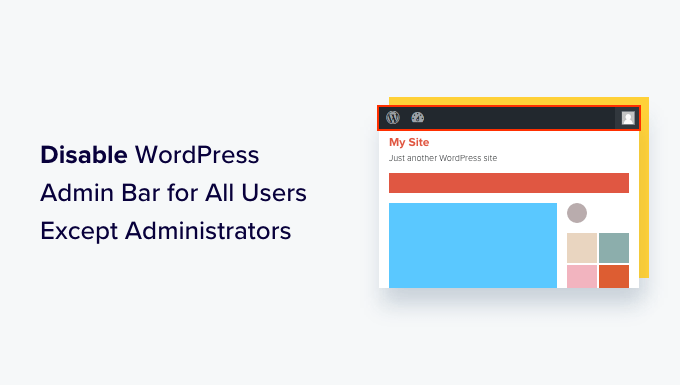
Qu’est-ce que la barre d’administration de WordPress ?
Par défaut, WordPress affiche une barre d’administration en haut de l’écran pour tous les utilisateurs/utilisatrices connectés. Lorsque vous êtes connecté à votre compte, vous pouvez voir cette barre d’outils dans la zone d’administration de WordPress et dans toutes les autres pages.
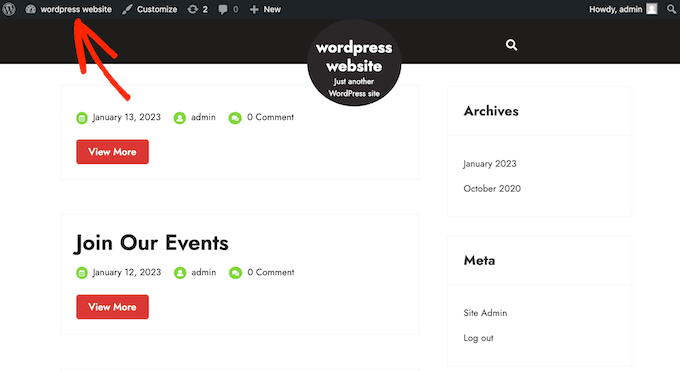
La barre d’outils d’administration de WordPress comporte des raccourcis utiles vers différentes interfaces d’administration de WordPress, et ces raccourcis sont modifiés en fonction du rôle et des droits de l’utilisateur dans WordPress.
Cependant, la barre d’administration peut être gênante lorsque vous regardez l’interface publique de votre site.
Il peut également affecter la conception de votre site et l’expérience de l’utilisateur. Cela peut être un problème si vous construisez ou gérez un site WordPress pour un tiers, car cela l’empêche de voir à quoi ressemble réellement son site.
Heureusement, il existe plusieurs façons de désactiver la barre d’administration pour tous les utilisateurs/administratrices. Il vous suffit d’utiliser les liens rapides ci-dessous pour passer à la méthode que vous souhaitez utiliser :
Tutoriel vidéo
Si vous préférez les instructions écrites, continuez à lire.
Méthode 1 : Désactiver la barre d’administration de WordPress pour les utilisateurs/utilisatrices individuels
Vous pouvez désactiver la barre d’administration pour des utilisateurs/utilisatrices spécifiques en modifiant simplement leur compte utilisateur. Cette méthode est simple et rapide si vous souhaitez retirer la barre d’administration pour un petit nombre de personnes. Cependant, si vous gérez un site d’adhésion avec un grand nombre d’utilisateurs/utilisatrices, nous vous recommandons de choisir une autre méthode.
Pour supprimer la barre d’administration manuellement, il suffit d’aller sur la page Utilisateurs » Tous les utilisateurs dans le tableau de bord WordPress. Survolez ensuite avec votre souris l’utilisateur qui n’a pas besoin de la barre d’administration, et cliquez sur » Modifier » lorsqu’il apparaît.
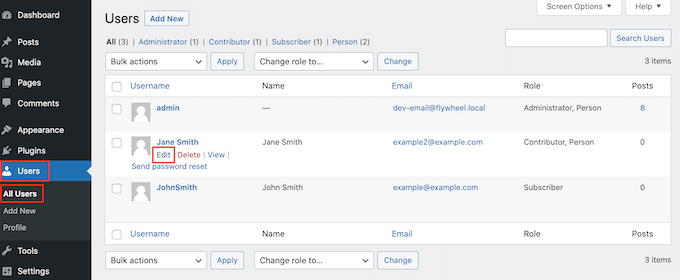
Le profil de l’utilisateur s’ouvre alors.
Décochez ensuite la case située à côté de l’option « Afficher la barre d’outils lors de la vue du site ».
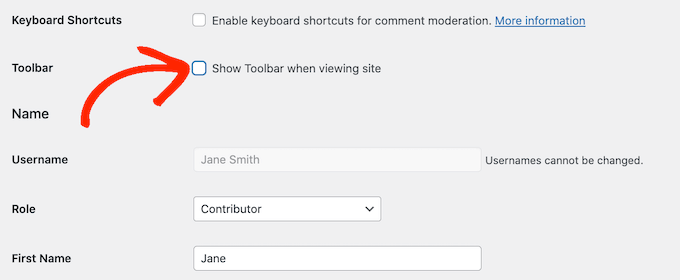
Ensuite, défilez jusqu’au bas de l’écran et cliquez sur « Mettre à jour l’utilisateur » pour enregistrer vos modifications. La barre d’administration sera alors désactivée uniquement pour cette personne.
Pour masquer la barre d’outils pour d’autres utilisateurs/utilisatrices, il suffit de suivre la même procédure que celle décrite ci-dessus.
Méthode 2 : Désactiver la barre d’administration pour tous les utilisateurs/utilisateurs sauf les administrateurs (recommandé)
Si vous devez masquer la barre d’administration pour un grand nombre de personnes différentes, la modification manuelle des Réglages de chaque utilisateur prendrait beaucoup de temps et d’efforts.
Pour cette raison, nous recommandons de désactiver la barre d’administration en ajoutant du code au fichier functions.php, qui est un fichier de thème WordPress. Si vous n’avez jamais fait cela auparavant, alors consultez notre guide sur la façon de copier et coller des extraits de code dans WordPress.
Certains guides vous indiqueront de modifier les fichiers du thème manuellement, mais cela peut entraîner des modifications courantes de WordPress et même casser complètement votre site.
C’est pourquoi nous vous recommandons d’utiliser WPCode. Il s’agit de la meilleure extension d’extraits de code et facilite l’ajout de code personnalisé dans WordPress sans mettre votre site en danger.
Tout d’abord, vous devrez installer et activer l’extension gratuite WPCode. Pour plus d’informations, consultez notre guide étape par étape sur l’installation d’une extension WordPress.
Une fois l’extension activée, allez dans Extraits de code » Ajouter un extrait.
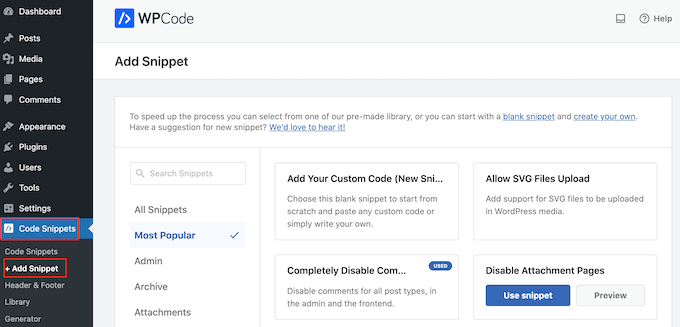
Vous consulterez cette page pour connaître tous les extraits prédéfinis que vous pouvez ajouter à votre site. Cela inclut un extrait qui vous permet de désactiver complètement les commentaires, de téléverser des types de fichiers que WordPress ne supporte généralement pas, de désactiver les pages de fichiers joints, et bien plus encore.
Sur l’écran suivant, vous devez survoler l’option « Ajouter votre code personnalisé (nouvel extrait) » et cliquer sur le bouton « Utiliser l’extrait » lorsqu’il apparaît.
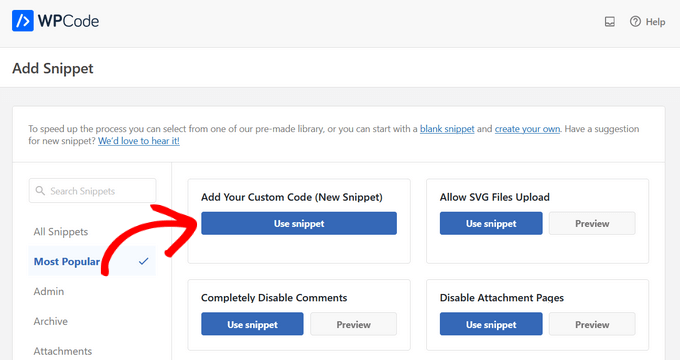
Dans l’écran suivant, saisissez un titre pour l’extrait de code. Il s’agit d’un titre de référence, vous pouvez donc utiliser ce que vous voulez.
Ensuite, ouvrez le menu déroulant « Type de code » et choisissez « Extrait de PHP ».
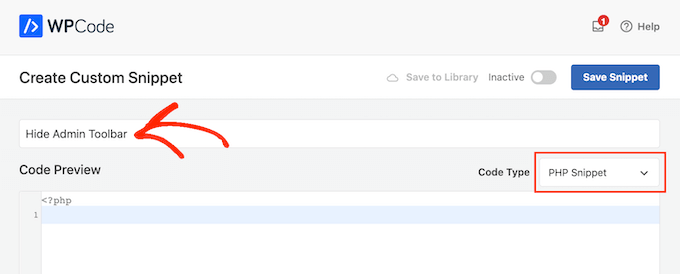
Cela fait, il suffit de coller le code suivant dans l’éditeur :
add_action('after_setup_theme', 'remove_admin_bar');
function remove_admin_bar() {
if (!current_user_can('administrator') && !is_admin()) {
show_admin_bar(false);
}
}
Ce code identifie tous les utilisateurs/utilisatrices non administrateurs qui ne sont pas en train de consulter le tableau de bord de l’administrateur. Pour ces utilisateurs/utilisatrices, il désactive la barre d’administration de WordPress.
Ensuite, défilez vers le bas de la page jusqu’à la section « Insertion ». Ici, vous pouvez conserver la méthode d’insertion automatique par défaut pour vous assurer que le code s’exécute partout.
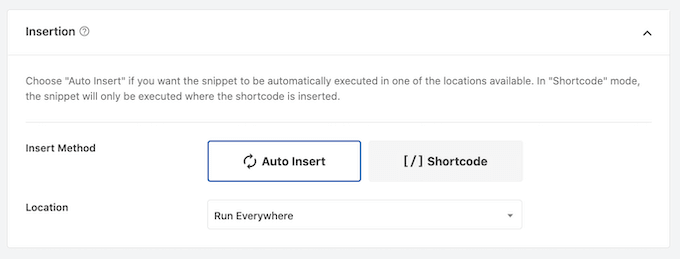
Enfin, défilez jusqu’en haut de l’écran et cliquez sur le Diaporama « Inactif » pour qu’il affiche « Actif ».
Il suffit ensuite de cliquer sur le bouton « Enregistrer l’extrait » ou « Mettre à jour » pour que l’extrait de code soit direct.
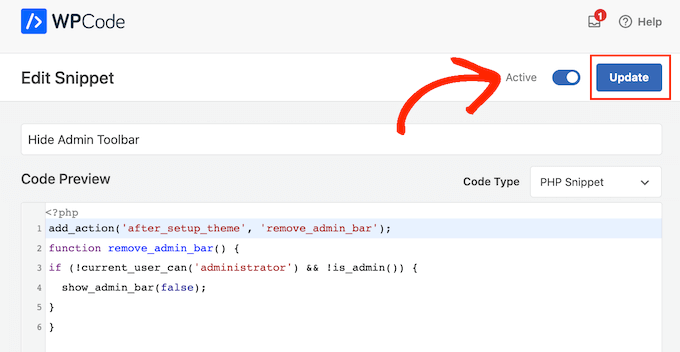
Voilà, c’est fait ! N’oubliez pas de vérifier votre site WordPress pour vous assurer que tout fonctionne correctement.
Méthode 3 : Désactiver la barre d’administration de WordPress pour tous les utilisateurs/utilisatrices sauf les Prérequis (Aucun code nécessaire)
Si vous ne voulez pas ajouter de code à votre site, alors vous pouvez masquer la barre d’administration à l’aide d’une extension. Hide Admin Bar Based on User Roles vous permet de retirer la barre d’outils en fonction des différents rôles des utilisateurs, c’est donc un bon choix si vous souhaitez désactiver la barre pour tous les membres, les clients WooCommerce, ou un autre rôle d’utilisateur.
Tout d’abord, vous devez installer et activer le plugin Masquer la barre d’administration en fonction des rôles des utilisateurs/utilisatrices. Pour plus de détails, consultez notre guide étape par étape sur l ‘installation d’une extension WordPress.
Une fois activé, vous devez vous rendre sur la page Réglages » Masquer la barre d’administration. De là, cochez les cases à côté des rôles du compte de l’utilisateur pour lesquels vous souhaitez désactiver la barre d’administration.
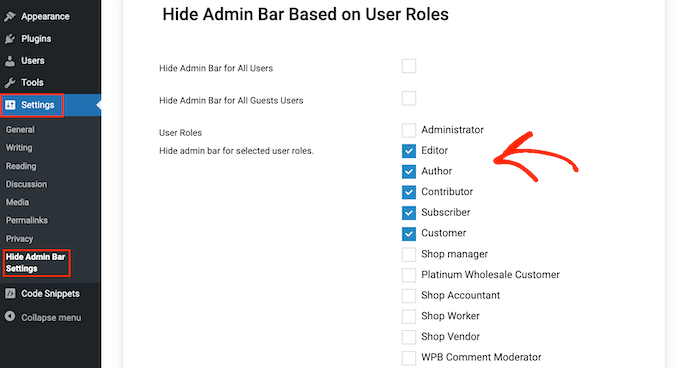
Une fois cela fait, il suffit de cliquer sur « Enregistrer les modifications » pour stocker vos réglages.
Méthode 4 : Désactiver la barre d’administration pour tous les utilisateurs/utilisatrices (y compris les administrateurs)
Souhaitez-vous désactiver la barre d’administration pour tous les utilisateurs/utilisatrices, y compris les admins du site ?
Vous pouvez le faire en ajoutant un code qui désactive la barre d’administration pour toutes les personnes qui voient les pages publiques de votre site. Cela signifie que la barre d’administration apparaîtra uniquement lorsque vous serez dans la zone du Tableau de bord WordPress.
Pour simplifier les choses, WPCode dispose de l’extrait de code exact dont vous avez besoin dans sa Bibliothèque d’extraits de code intégrée. Il vous suffit d’aller dans Extraits de code « Bibliothèque.
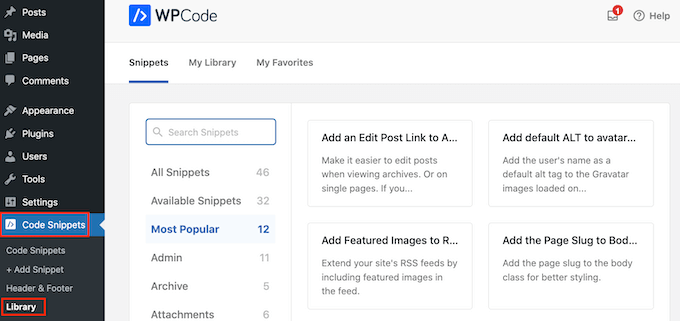
Recherchez « Disable The WP Admin Bar » (Désactiver la barre d’administration de WP).
Lorsque l’extrait souhaité s’affiche, il suffit de cliquer sur le bouton « Utiliser l’extrait ».
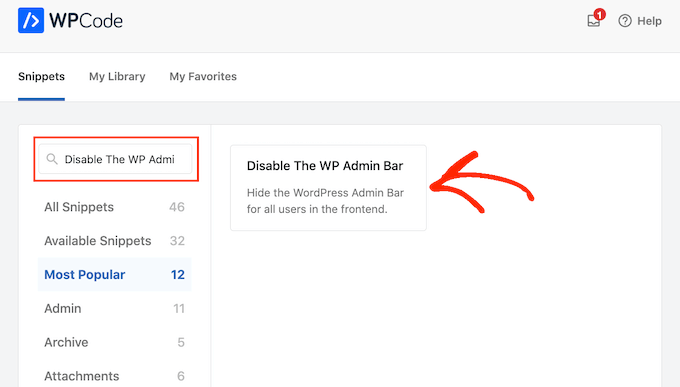
L’extension ajoutera automatiquement le code à votre site, lui donnera un titre descriptif, choisira la bonne méthode d’insertion et ajoutera même des identifiants pour vous aider à identifier l’extrait.
Voici à quoi ressemble le code :
/* Disable WordPress Admin Bar for all users */
add_filter( 'show_admin_bar', '__return_false' );
Il ne vous reste plus qu’à permuter le commutateur de « Inactif » à « Actif », puis à cliquer sur « Mettre à jour ».
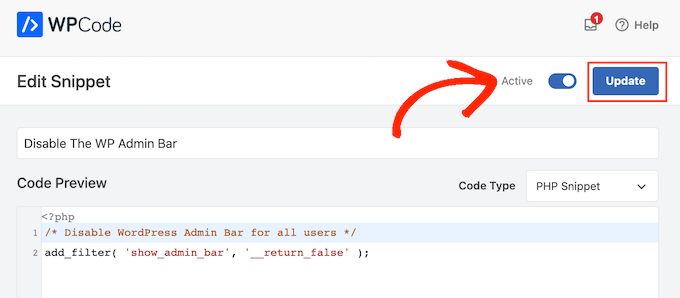
Désormais, si vous visitez l’interface publique de votre site tout en étant connecté à votre compte WordPress, la barre d’administration disparaîtra.
Nous espérons que cet article vous a aidé à apprendre comment désactiver la barre d’administration de WordPress pour tous les utilisateurs/administratrices. Vous pouvez également consulter notre guide ultime sur la sécurité WordPress et notre comparaison des meilleurs constructeurs de pages WordPress pour créer des mises en page personnalisées sans aucun code.
Si vous avez aimé cet article, veuillez alors vous abonner à notre chaîne YouTube pour obtenir des tutoriels vidéo sur WordPress. Vous pouvez également nous trouver sur Twitter et Facebook.





Syed Balkhi says
Hey WPBeginner readers,
Did you know you can win exciting prizes by commenting on WPBeginner?
Every month, our top blog commenters will win HUGE rewards, including premium WordPress plugin licenses and cash prizes.
You can get more details about the contest from here.
Start sharing your thoughts below to stand a chance to win!
Moinuddin Waheed says
This is very needed to hide the admin bar to all the user’s except the administrator.
I have thought of doing this multiple times over specially when I was running news website and I had many authors and contributors.
Showing them admin bar is not only unnecessary but annoying too.
Really appreciate for the steps to get rid of this admin bar and keep it for only the administrator.
Amos Showole says
Wow… This is great, you solved an issue I faced with on one of my WordPress website that BuddyPress was installed on….
WPBeginner Support says
Happy to hear our guide was helpful!
Administrateur
Hussam H says
Thank you and bless you.
WPBeginner Support says
You’re welcome!
Administrateur
Paul says
Using the after_setup_theme hook doesn’t always work. Try this instead:
function remove_admin_bar( $value ) {
return ( current_user_can( ‘administrator’ ) ) ? $value : false;
}
add_filter( ‘show_admin_bar’ , ‘remove_admin_bar’);
Matthew D Henderson says
Thank you for providing four different ways to do this. Perfect
WPBeginner Support says
Glad you found our recommendations helpful
Administrateur
Joey says
What would be the code if I want to add Editor and Admin to show the Admin bar..
if (!current_user_can(‘administrator’) && !is_admin())…
if (!current_user_can(‘editor’) && !is_editor())…
would it be if (!current_user_can(‘administrator’) && !is_admin() || !current_user_can(‘editor’) && !is_editor())
would this work?
WPBeginner Support says
For what you are wanting, you would want to remove: && !is_editor()
Then it should work how you are wanting.
Administrateur
Basia says
Hi,
I hide admin bar with plugin You recommend, but when subscriber log in he can still click on « view my profile » and see wp dashboard. Can I disable that?
WPBeginner Support says
You can redirect users after login using the method from our guide below:
https://www.wpbeginner.com/plugins/how-to-redirect-users-after-successful-login-in-wordpress/
Administrateur
Deewinc says
Thanks for the article but method 3 doesn’t work.
WPBeginner Support says
If method 3 is not working for you, we would recommend trying one of the other methods to test.
Administrateur
Dipesh Vedak says
what if theme upgrades?
WPBeginner Support says
If you created a site-specific plugin it would remain.
Administrateur
Brandon Porter says
Worked like a charm. Thank you!
WPBeginner Support says
You’re welcome, glad our guide was helpful
Administrateur
Bryan E Jackson says
Doesn’t seem to work for my Divi Theme
WPBeginner Support says
You may want to try clearing your cache for the most common reason for the change not being visible.
Administrateur
Paul says
What exactly does this disable? I still see an admin bar and I have access to menu options when I go to example.com/wp-admin when i’m logged into a subscriber account.
WPBeginner Support says
You would want to ensure the code was properly added for the most likely cause of the admin bar not being hidden otherwise, you could also have a plugin that would be overriding this code.
Administrateur
Jürgen says
Thanks. Just what I needed
WPBeginner Support says
Glad our guide was helpful
Administrateur
khaoula says
Thanks a lot ,but what to do if the user wants to logout ?
WPBeginner Support says
You can add a logout link to your menu for one option, we have a guide on how to do that below.
https://www.wpbeginner.com/wp-tutorials/how-to-add-the-wordpress-logout-link-to-navigation-menu/
Administrateur
Kaetech says
Thanks a lot. Just what I needed. It worked.
WPBeginner Support says
You’re welcome, glad our guide was helpful
Administrateur
Marc Korden says
Cannot add the admin code in my theme:
Communication with the site not possible to check for errors, the PHP adjustment has been reversed. The PHP file change needs to be changed in another way, for example using SFTP.
WPBeginner Support says
That message means that WordPress was not able to check the code for errors and you would need to use an FTP tool to add the code. We have a guide you can follow below:
https://www.wpbeginner.com/beginners-guide/how-to-use-ftp-to-upload-files-to-wordpress-for-beginners/
Administrateur
Jailson Pacagnan Santana says
Thanks! God bless you
WPBeginner Support says
You’re welcome, glad our guide was helpful
Administrateur
Ciao says
Where should i exactly insert the code, at the beginning, at the end of funcions.php? thx
WPBeginner Support says
We normally recommend at the end so it is easy to find and remove if needed
Administrateur
Agha Mubasher says
Hello there…!
First of all i simply love the work wpbeginner, as you always bring forward the simplest solutions to our wordpress issues. Your website and Youtube channel has always been helpful for me. Thumbs Up for that..
I had issue with hiding the admin bar for the subscribers only. Now after applying your code in the function.php it is hidden for my editors also.
Is there any way that my editors also can see the admin bar and only it should be hidden from the subscribers..!!
WPBeginner Support says
For that, you would need to target another permission that your editor has instead of what we are targeting such as edit_others_posts
Administrateur
Felix says
Thank you very much.
WPBeginner Support says
You’re welcome
Administrateur
Dana Jewel says
Thank you! This snippet has been really, really helpful.
WPBeginner Support says
You’re welcome, glad our guide could be helpful
Administrateur
Faris says
Great Help, It worked like a charm!
Thank You so much.
WPBeginner Support says
You’re welcome
Administrateur
Jesaja says
On my website it says:
« Unable to communicate back with site to check for fatal errors, so the PHP change was reverted. You will need to upload your PHP file change by some other means, such as by using SFTP. »
What to do now?
WPBeginner Support says
It means the new WordPress safety features prevented you from editing the file, you would need to download and edit your theme’s files using FTP: https://www.wpbeginner.com/beginners-guide/how-to-use-ftp-to-upload-files-to-wordpress-for-beginners/
Administrateur
Jesaja says
Oh.. can’t I just put it in the Custom CSS area?
WPBeginner Support says
No, this is PHP not CSS so it wouldn’t go into there.
TaiRon says
It does work like a chame, your code is perfect but I have to change in file manager directly.
Thanks.
WPBeginner Support says
You’re welcome, glad our guide could help
Administrateur
Bongani says
Thanks , very useful tutorial
WPBeginner Support says
You’re welcome
Administrateur
Mike says
Thank you!
WPBeginner Support says
You’re welcome
Administrateur
Jim says
Can this code be altered to allow the WordPress Admin bar for Admins AND moderators, but hide it for everyone else?
Thanks!
WPBeginner Support says
You would need to add another && !current_user_can( ») inside the parentheses with the name of the role you are wanting it to appear on or use the plugin adminimize from our article: https://www.wpbeginner.com/wp-tutorials/what-everybody-ought-to-know-about-the-wordpress-admin-bar/
Administrateur
Andreas says
If a user knows the URL structure of WordPress he can easily browser to /wp-admin/ and there the admin toolbar will be visible. Also, the easiest way is to deactivate it in the user setting if you have a small number of users.
Adam Pressman says
Doesn’t work. Well, to be fair, works when you first use it but then something happens and it doesn’t anymore. nothing is overwriting the functions.php and the code is there but usually after the first login, logout cycle a subsequent login will see the admin bar return.
prashanth says
It works but user cannot logout. How to logout?
Cesar says
I have created a social media site using several plugins and everything works fine but for one issue. Pages are successfully restricted and redirected (Buddypress pages, blogs, etc) for non-logged in users.
However the main issue I am having is that non-logged in users can still have access to blog posts and user profile pages via widgets placed on side bar and footer and I cannot seem to find a solution anywhere.
Any ideas on the matter, plugins or code that I can insert in the child theme?
I have been looking for a solution for over a day and all there is there is how to restrict pages and partial content but nothing works on the widget links, they keep going thru the restrictions in place.
Thanks
WPBeginner Support says
Hey Cesar,
There are several widgets and plugins that allow you to hide widgets from non-logged in users. However, if non-logged in users know the URL, then they would still be able to access those URLs directly. You need to review your plugin settings and see if you can find the option to hide profile pages from non-logged in users.
Administrateur
Shabz says
This code or several others that I tried from the comments isn’t working. I’m trying to remove that dumb silver/black wordpress tab above my menu that shows up for all of my website’s users. How do I remove that? Please help
Humberto Buitrago says
Is there any plugin we can use instead code?
Thanks in advanced!
Jack Hernandez says
As mentioned in the article, you included a way for users to edit their profiles through the front end without the admin bar. How did you accomplish that.
Thanks
Paritosh Negi says
Thank you so much! <3 it works well
Chouchouda says
Hello, some issue , i have done everything but can’t hide toolbar for owner user in frontend , but can do this for admin user , incredible.
I’m using search& go theme wordpress , Thank for your help.
Alex says
Hello,
Code needs a little updating. This is the code I would use to redirect by role.
/*Hide admin bar for certain roles*/
function hide_admin_bar() {
if(is_user_logged_in() ) {
$current_user = wp_get_current_user();
if ( in_array( ‘subscriber’, (array) $current_user->roles ) ) {
add_filter(‘show_admin_bar’, ‘__return_false’);
}
}
}
Hope this helps.
Brandon says
Thanks for this updated code, Alex. Simple and works great.
Put it in child theme functions.php and forget about it.
Yuki Zain says
Thanks, Alex but I’m editing a bit
/*Hide admin bar for certain roles*/
if(is_user_logged_in() ) {
$current_user = wp_get_current_user();
if ( in_array( ‘subscriber’, (array) $current_user->roles ) ) {
add_filter(‘show_admin_bar’, ‘__return_false’);
}
}
randalf says
Very nice but what do I do if I have two roles as a result of bbpress plugin.. That is registered users have the subscriber role in whole site and participant role in bbpress.
but what do I do if I have two roles as a result of bbpress plugin.. That is registered users have the subscriber role in whole site and participant role in bbpress.
Please help
Scott says
Hi,
I inserted your code to remove the Admin bar from my membership site. Unfortunately it also removed it from me, the Admin (even thought I used your first option above). I am using the Tesseract Pro theme. Do you have any suggestions? Thanks
Inder Singh says
Dear Sir,
I have 2 admin user and i want to show admin bar for first user and remove admin bar for second user in wordpress.
How can i do it.
Thanks for support.
SG says
I tried using this and I got that code Parse error: syntax error, unexpected ‘}’ in /home/content/76/10323476/html/wp-content/themes/digitalscience-apex/functions.php on line 168 and I can’t get my site back even after deleting it.
Krzysiek Dróżdż says
Well, I wouldn’t use current_user_can for that… Codex says, that you can use it for role checking, but in the code you can find:
* While checking against particular roles in place of a capability is supported
* in part, this practice is discouraged as it may produce unreliable results.
So… Much better and secure way to do this is:
$user = wp_get_current_user();
if ( ! in_array( ‘administrator’, (array) $user->roles ) ) {
…
}
Rajdeep dey says
This code not working on my website… Did any one have any other solutions for hiding admin bar.
Lyndal Sirit says
i used it and it crashed my site, trying desperately to fix it now, i took the code back out and updated but I am getting an Error: Parse error: syntax error, unexpected ‘3’ (T_LNUMBER) in /home/lyndalspirit/public_html/wp-content/themes/primer/functions.php on line 516
WPBeginner Support says
Hi Lyndal,
Some times when users copy code from websites like WPBeginner, they also copy the line numbers which they are not supposed to copy. When they paste this code in their functions.php file it causes an error.
You need to connect to your site using an FTP client. Locate your functions.php go to the code you added and remove it. Save your changes.
Administrateur
SG says
Even after deleting it, my site is coming back HELP!
Chris says
This worked fine for me as-is, i stripped out the line numbers and stuck it at the end of my theme functions.php – instant success. thanks so much.
WPBeginner Support says
Hey Chris,
Glad you found it useful. Don’t forget to join us on Twitter for more WordPress tips and tutorials.
Administrateur
Job says
The Code works like charm. Thanks.
eli says
if(!current_user_can(‘administrator’)) {
add_filter(‘show_admin_bar’, ‘__return_false’);
}
Gordon Cockburn says
How do I remove an individual ex member from access to members only area of website
WPBeginner Support says
Login to your WordPress admin area using an Administrator account. Click on the Users menu item from the admin sidebar. This will show you a list of users registered on your WordPress site. Locate the user you wish to remove. Click on the Delete link below the username of the person you want to remove.
Administrateur
Jguiss says
Didn’t worked for me…
It’s worked with that : add_filter(‘show_admin_bar’, ‘__return_false’);
JGUISS says
JGUISS
Didn’t worked for me…
It’s worked with that : add_filter(‘show_admin_bar’, ‘__return_false’);
how does the code look like with this added I’m not familiar enough with php to add it in
The Little Binger says
Hello!
Thank you so much for being such a great help! I installed this code on the function file but it does not seem to work. I loaded my page on a different browser but the Log In bar is still there. Why is that? I also read your article about adding codes to the PHP file.
I hope you could help me out on this. Thanks!!
Vic says
Hi! First of all, thanks for these codes, it’s very helpful, provided I considered myself not a first timer anymore who remember to add after the codes!

I locked myself at the first time trying to add the php coding in my functions.php file as well, thanks to the « expert » web developer who didn’t show the full set of codes for a function. And thanks to your « what to do when you are locked out of WordPress admin area » site, I found out why I was locked out in the first place! But it took me a downtime of 3 days to figure out how to use the FTP, which at the end failed to function, but my webhost Helpdesk suggested me to use the File Manager in their Control Panel instead! Luckily it works! Lessons learnt the hard way, but worth it..
Just a kind suggestion, since this site was supposed meant for « WPBeginner », I think all of the WP users beginner would appreciate if full set of codes are provided, rather than every other person « shouting » in the comment section that « The codes didn’t work, and locked me out », and then you have to advise them to read a full length of another tutorial how to unlock their website, even though yes, you wish to teach us « How to fish » instead of « Fish for us » every time!
Anyway, thanks again and appreciate your efforts here in guiding us, the WP Beginners!
WPBeginner Support says
Thanks for the feedback. We try to make code easy to paste and use. However, usually there is already code in your functions.php file, which may affect the end result. We are glad you found your way out.
Administrateur
Louis says
It works just perfect!
Easy and functional.
Thank u!